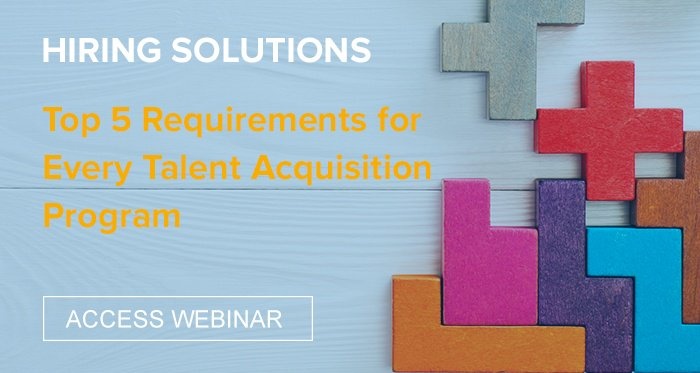
Hiring unpredictability - the sudden or unexpected need to make hiring decisions that had not been forecasted prior - is a stressful and often damaging component of talent acquisition. While some organizations bring this unpredictability upon themselves by failing to perform proper forecasting and research, other organizations navigate unpredictability as a natural part of their business.
Thankfully, hiring unpredictability is rarely something a business can do nothing about. In fact, most cases of hiring unpredictability can be avoided with planning, communication, and vigilance, says Pam Verhoff, President at AdvancedRPO, a Chicago-based RPO company that helps deliver tailored strategic recruitment process outsourcing solutions.
Hiring Solutions: Top 5 Requirements for Every Talent Acquisition Program
Common Hiring Unpredictability Causes
Many cases of hiring unpredictability come down to big shifts in a business, like large growth and expansion. Organizations that rely on contracts or private equity for example can often find themselves needing to make a number of sudden hires to fulfill the new projects on their plate, says Verhoff.
For some businesses, hiring unpredictability comes with the territory. During his conversation with Erin Peterson on “Big Fish in the Hiring Pool,” David Reed of Vail Resorts described how hiring for resorts followed a predictable, but mutable, onboarding and offloading season. While summer and winter saw the most number of visitors to the resort, and thus requires a higher level of hires than the off seasons, other unpredictable factors such as the weather and economy could also affect visitors for a given season. For Reed, unpredictability, adaptability and preparation were intrinsic to the business.
And sometimes, some businesses simply aren’t great at forecasting their hiring needs, observes Verhoff. For example, HR might structure their recruiting to manage a certain number of individuals but haven’t planned ahead to account for imminent changes in the business. The result is these businesses have the rug pulled out from under them, and “their talent acquisition team bears the brunt of the impact,” says Verhoff.
Case Study: Managing Aggressive Hiring Growth
Communication is Key
Given the nature of hiring, it should come as little surprise that a lack of internal communication is one of the largest problems organizations face when it comes to dealing with hiring unpredictability, says Verhoff.
“If HR is not really a strategic partner to the business, then they’re less effective,” she explains. “It’s important that whoever is accountable for [hiring forecasting] is really ingrained in the business so that it shifts talent acquisition to be more proactive. When I think unpredictability, I think it puts talent acquisition into a reaction mode.”
Stop! Does Your Talent Acquisition Program Align With Your Business Strategy?
Having the mechanisms in place to convey this sort of information naturally is key, says Verhoff. Though it might sound obvious, some organizations operate without the full communication mechanisms that would support the adjustments needed to stay ahead of hiring changes.
“The good news is its relatively easy to fix,” says Verhoff.
Staying prepared
The best way to stay on top of hiring unpredictability is to start with the basics, including your HR team having a solid understanding of the current market. That includes things like the anticipated turnover and business growth over a period of time. Your HR team needs to ask themselves a few questions about their current hiring practices and what they might expect.
“If the business is expected to grow 20 percent year over year, what headcount impact might that have? Are we going to expand our sales team by ‘x’ amount?”
Whatever the factors that go into your changing market conditions, that should go into a workforce plan that influences how your team approaches hiring and builds out the hiring program to support the hiring goals for that year.
Who exactly is responsible for the oversight of marketing conditions and communicates them between HR and TA depends on the size of your organization. Talent acquisition is the most common department tasked with this oversight, but not all TA teams have the bandwidth to effectively manage the task. Other organizations have HR generalists for most of their recruiting needs, who often don’t necessarily love recruiting, notes Verhoff.
“That’s a big opportunity for us,” she adds.
Outsourcing is a strategic decision many businesses make, especially those with lots of natural variability in their hiring needs, such as the variations experienced by David Reed at Vail Resorts. This same decision is often made by smaller organizations, notes Verhoff, as it allows them to focus on their primary business goals first and foremost.
A Big Fish Diary: Being Strategic With Seasonal Hiring
New market intelligence tools are also growing much more important for handling hiring unpredictability. These intelligence tools allow organizations to gather and interpret data important to understanding the market and labor fluctuations that affect their hiring needs. Many of these tools can now present that information in a simplified, easy to understand manner, making it much simpler to pass this information along to the hiring managers and let them plan accordingly.
At the end of the day, the most common mistake organizations make is expecting that the talent acquisition team is going to be able to effectively react to sudden changes in hiring needs, says Verhoff.
“Putting them in a reactive mode is a big mistake…the reality is, we don’t make the best decisions when reacting.”
Strong cross-communication and a trustful partnership between TA and those monitoring market conditions is the best defense against hiring unpredictability – the more continuous and frequent, the less friction your hiring will encounter.
Find additional resources on hiring & recruiting best practices.















